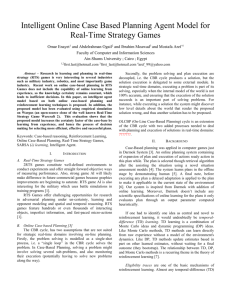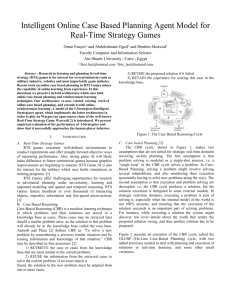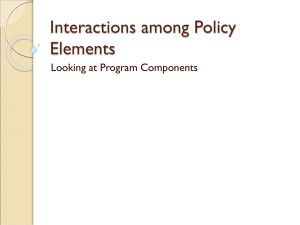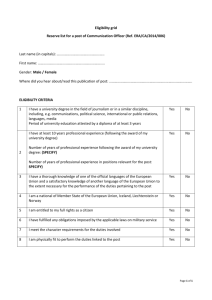Preparation of Papers in a Two-Column Format for the IEEE IROS
advertisement
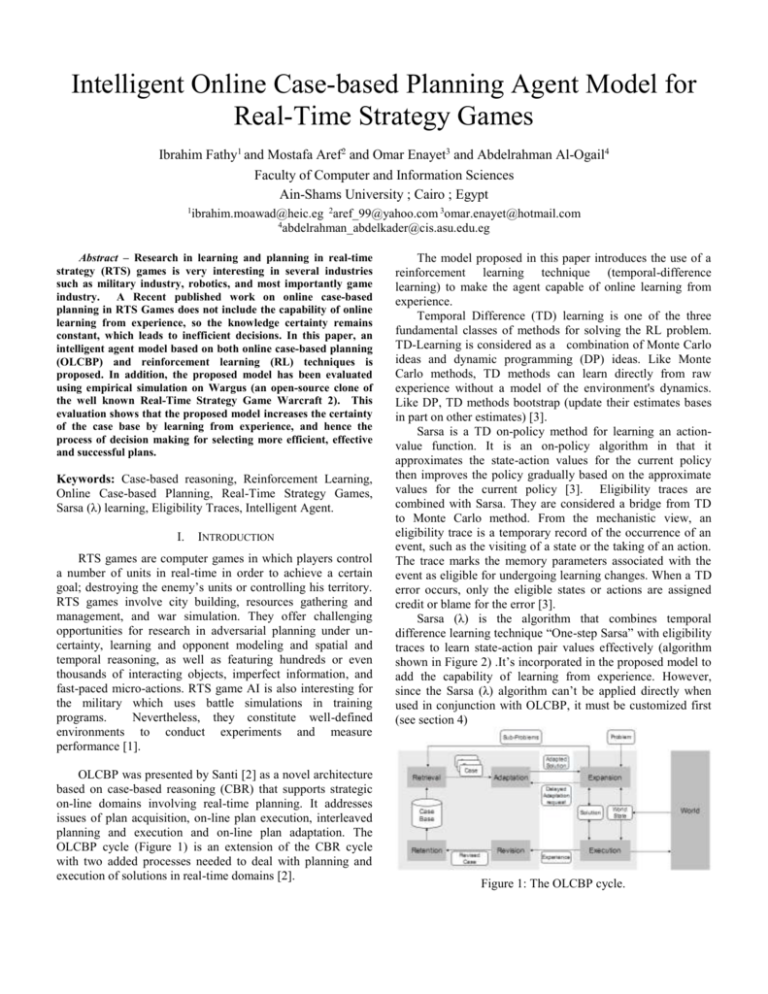
Intelligent Online Case-based Planning Agent Model for Real-Time Strategy Games Ibrahim Fathy1 and Mostafa Aref2 and Omar Enayet3 and Abdelrahman Al-Ogail4 Faculty of Computer and Information Sciences Ain-Shams University ; Cairo ; Egypt 1 ibrahim.moawad@heic.eg 2aref_99@yahoo.com 3omar.enayet@hotmail.com 4 abdelrahman_abdelkader@cis.asu.edu.eg Abstract – Research in learning and planning in real-time strategy (RTS) games is very interesting in several industries such as military industry, robotics, and most importantly game industry. A Recent published work on online case-based planning in RTS Games does not include the capability of online learning from experience, so the knowledge certainty remains constant, which leads to inefficient decisions. In this paper, an intelligent agent model based on both online case-based planning (OLCBP) and reinforcement learning (RL) techniques is proposed. In addition, the proposed model has been evaluated using empirical simulation on Wargus (an open-source clone of the well known Real-Time Strategy Game Warcraft 2). This evaluation shows that the proposed model increases the certainty of the case base by learning from experience, and hence the process of decision making for selecting more efficient, effective and successful plans. Keywords: Case-based reasoning, Reinforcement Learning, Online Case-based Planning, Real-Time Strategy Games, Sarsa (λ) learning, Eligibility Traces, Intelligent Agent. I. INTRODUCTION RTS games are computer games in which players control a number of units in real-time in order to achieve a certain goal; destroying the enemy’s units or controlling his territory. RTS games involve city building, resources gathering and management, and war simulation. They offer challenging opportunities for research in adversarial planning under uncertainty, learning and opponent modeling and spatial and temporal reasoning, as well as featuring hundreds or even thousands of interacting objects, imperfect information, and fast-paced micro-actions. RTS game AI is also interesting for the military which uses battle simulations in training programs. Nevertheless, they constitute well-defined environments to conduct experiments and measure performance [1]. OLCBP was presented by Santi [2] as a novel architecture based on case-based reasoning (CBR) that supports strategic on-line domains involving real-time planning. It addresses issues of plan acquisition, on-line plan execution, interleaved planning and execution and on-line plan adaptation. The OLCBP cycle (Figure 1) is an extension of the CBR cycle with two added processes needed to deal with planning and execution of solutions in real-time domains [2]. The model proposed in this paper introduces the use of a reinforcement learning technique (temporal-difference learning) to make the agent capable of online learning from experience. Temporal Difference (TD) learning is one of the three fundamental classes of methods for solving the RL problem. TD-Learning is considered as a combination of Monte Carlo ideas and dynamic programming (DP) ideas. Like Monte Carlo methods, TD methods can learn directly from raw experience without a model of the environment's dynamics. Like DP, TD methods bootstrap (update their estimates bases in part on other estimates) [3]. Sarsa is a TD on-policy method for learning an actionvalue function. It is an on-policy algorithm in that it approximates the state-action values for the current policy then improves the policy gradually based on the approximate values for the current policy [3]. Eligibility traces are combined with Sarsa. They are considered a bridge from TD to Monte Carlo method. From the mechanistic view, an eligibility trace is a temporary record of the occurrence of an event, such as the visiting of a state or the taking of an action. The trace marks the memory parameters associated with the event as eligible for undergoing learning changes. When a TD error occurs, only the eligible states or actions are assigned credit or blame for the error [3]. Sarsa (λ) is the algorithm that combines temporal difference learning technique “One-step Sarsa” with eligibility traces to learn state-action pair values effectively (algorithm shown in Figure 2) .It’s incorporated in the proposed model to add the capability of learning from experience. However, since the Sarsa (λ) algorithm can’t be applied directly when used in conjunction with OLCBP, it must be customized first (see section 4) Figure 1: The OLCBP cycle. The next section gives a brief background about related work based on OLCBP and hybrid CBR/RL techniques. Section 3 describes the general architecture of the proposed intelligent case-based planning agent model. Section 4 explains how OLCBP and RL using Sarsa (λ) are hybridized. Section 5 evaluates the proposed model by applying empirical simulation on Wargus game. Finally, section 6 concludes the work presented in this paper and presents new ideas for future work. Using case-based reasoning in support of reinforcement learning or vice versa is not a novel idea. Sharma [5] presented a multi-layered architecture named CARL (Casebased Reinforcement Learner) for achieving transfer learning using a hybrid CBR/RL approach and applied it to RTS games. CARL uses the RL algorithm, Q-Learning, in order to revise the cases. CARL, however; doesn’t support many features that are found in Darmok such as case acquisition, case adaptation … etc. Johansen [6] presented another CBR/RL system for learning micro-management in RTS games, however; it doesn’t target high level planning. Molineaux [7] presented an RL/CBR algorithm to learn continuous action models for selecting actions in RTS Games. Apart from RTS Games, Gabel [8] used CBR for function approximation. Finally, Bianchi [9] improved RL using casebased heuristics. The work presented in this paper is based on Darmok [2] with the addition of the capability of learning from experience and evaluating cases using the Sarsa (λ) RL algorithm. This evaluation let the system choose not only the most suitable plan for the current game state, but also the most efficient one. Figure 2: The original Sarsa (λ) algorithm. II. BACKGROUND Online case-based planning was implemented in the Darmok system [2]. Darmok solves the case acquisition problem by observing how human play with the support of human annotations. Darmok also, interleaves planning and execution on-line in order to achieve efficient on-line planning that is reactive to the current situation. It introduces the idea of delayed plan adaptation in order to insure its validity for the current time if the plan was retrieved earlier. Finally, Darmok implements plan adaptation techniques that are efficient to be executed on-line. III. INTELLIGENT OLCBP AGENT MODEL In this paper, a new AI agent model capable of online planning with online learning is introduced. The agent model architecture is considered as an evolution of the Darmok system [2] by adding the capability of learning from experience. As shown in Figure 5, the architecture consists of two main phases: an offline learning phase, and an online planning and learning phase. The offline learning phase –which is not our interest in this paper - is based on Santiago’s [4] work and is used to populate the cases in case base. Santiago [4] presented a set of algorithms that can be used to -automatically- learn plans from human demonstrations and thus an automatic approach for case acquisition. During case acquisition, the system starts to learn plans by observing game play and strategies between two different opponents (i.e. human and computer) and then, deduces and forms several cases. The system receives raw traces that form the game played by the human. Using Goal Matrix Generation, these traces are converted into raw plan. Further, a Dependency Graph is constructed for each raw plan, which lets the system be aware of the following points: 1) The dependencies between the raw plan steps. 2) Which plan steps are suitable to be executed in parallel? Next, a Hierarchal Composition for each raw plan is formed in order to shrink raw plan size and substitute group of related steps with the goal step. Finally, all the learnt plans are retained in the case base. Figure 3: Case representation. Each case is composed of 8 components (shown in Figure 3) 1. Goal: the goal that is achieved by the case plan. 2. Situation: where the case can be applied. 3. Shallow Features: set of sensed features from the environment which requires low computation overhead. 4. Deep Features: set of sensed features from the environment which requires high computation overhead. 5. Certainty Factor: a decimal that indicates the certainty of success when applying its case. Negative certainty factor means uncertain, while positive means certain. Its value constitutes the magnitude of certainty. 6. Eligibility Trace: a decimal that represents the responsibility (eligibility) of the case for reaching the current state. 7. Prior Confidence: a decimal, ranges between zero and one, set by an expert, indicating the confidence of success when using that case from the expert’s point of view. 8. Behavior: coins the actual plan to be used After the agent learns cases that serve as basic ingredients for playing the game [4], it then set to be ready to play against different opponents. The phase where the agent plays against opponents is called online planning and learning phase (i.e. online phase). The planning comes from expansion and execution of current plan whereas learning comes from the revision of the applied plans. The online planning and learning phase consists of expansion, execution, retrieval, adaptation, reviser, and current plan components. As shown in Figure 3, a behaviour consists of: preconditions that must be satisfied before the plan execution, alive conditions that must be satisfied while the plan is being executed, success conditions that must be satisfied after the plan has been executed, and snippet that is a set of the plan steps, where each plan step consists of a set of parallel actions/goals. The Expansion module expands ready open goals in the current plan. The Readiness means that all snippets before that goal were executed successfully while Opening means that this goal has no assigned behaviour. The Retrieval module selects the most efficient plan using: situation assessment to get most suitable plan, E-Greedy selection policy to determine whether to explore or exploit. Equation 1 in figure 4 shows the exploration/exploitation equation. In exploitation, the predicted performance of all cases is computed and the best case is selected using equation 2 of Figure 4. In exploration, a random case is selected. The situation assessment module is built through capturing most representative shallow features of the environment, building Situation-Model that maps set of shallow features to situation, building Situation-Case Model to classify each case for specific situation, and building Situation-Deep Feature Model to provide set of deep features that are important for predicted situation. The selected behaviour is passed to the Adaptation module to adapt the plan for the current situation. Adaptation means removal of unnecessary actions in the plan and then adding the satisfied actions. Figure 4: Retrieval process equations. Execution module starts to execute plan actions whenever their preconditions are satisfied. To execute plans, the execution module starts to search for ready snippets, and then sends these ready snippets for execution (to the game), updates the current status of executing snippets whether succeeded or failed and finally, updates status of executing actions from each snippet. After a complete snippet execution, the reviser module starts its mission. The importance of revision originated from the fact that interactive and intelligent agents must get feedback from the environment to improve their performance. The learnt plans were based on an expert’s actions which are not necessarily the best actions. The reviser adjusts the case performance according to Temporal Difference learning with Sarsa (λ) Online Policy Learning Algorithm. Finally, the adjusted plan is retained in the case base using the retainer module. Figure 5: Intelligent OLCBP agent model. 3) It retrieves all cases with a similar S (Goal and Situation) to the S of the retrieved case Cr and stores the result in E. IV. HYBRID OLCBP/RL ALGORITHM USING SARSA(λ) The approach presented in this paper hybridizes Online Casebased Planning (OLCBP) and Reinforcement Learning (RL) using a proposed new version of Sarsa (λ) algorithm (shown in Figure 6). In order to show how Sarsa (λ) algorithm has been customized, Table 1 maps the old symbols\meanings in the original Sarsa (λ) algorithm (shown in Figure 2) to the new symbols\meanings used in this work. 4) It updates the eligibility of all cases in E according to the following equation: e (C) = γ λ e (C) Where: λ is the trace decay parameter, which controls the rate of decay of the eligibility trace of all cases. As it increases, the cases preserve most of their eligibility and thus are affected more with any rewards or punishments. Every time the agent retrieves a case to satisfy a certain goal, the agent –in RL terms- is considered to have a new state, and starts the applying the algorithm, which goes through the following steps: Notice that only cases with similar goal and situation have their eligibility updated, since cases with similar goal and situation are considered to constitute a pool of states (in RL terms) that need to take the responsibility of choosing the current case and thus have their eligibilities updated. 1) It increments the eligibility of the retrieved case according to the following equation: e (Cr) = e (Cr) + 1 Where: Cr is the retrieved case. However, the performance of the entire case base is updated (mainly the used cases only, as unused cases will have an eligibility of zero and thus doesn’t change in value), because different types of cases affect each other’s performance, for example, a case achieving the “Build Army” goal will certainly affect the performance of the next used case which achieves the “Attack” goal. 2) It then updates the certainty factors of all cases in its case base according to the following equation: Q(C) = Q(C) + α δ e(C) Where α is the learning rate, e(C) is the eligibility of the case C and δ is the temporal difference error that depends on the following equation: δ = R + r + γ Q (Cr) – Q (Cu) Where: R: a global reward whose value depends on the ratio between the player’s power and the enemy’s power (the global consequence). It ranges between -1 and 1. It is very important for the agent to be aware of not only the direct consequences of its actions but also the global consequences. r: a case-specific reward due to the success or failure of the last used case(the direct consequence). It ranges between -1 and 1. It is computed based on a heuristic which determines how effective the plan was according to the following formula : γ Q (Cr) – Q (Cu) : The difference in certainty factor between the retrieved case Cr (multiplied with the discount rate γ) and the last used case Cu. Notice that, in online case-based planning there could be multiple last used cases executed in parallel; in this condition the total temporal difference error relative to all last used cases should be equal to: δ = R + ∑in ri + γ Q (Cr) – Q (Ci) Where n: number of last used cases Observe failed or succeeded Case Cu Compute R, r Retrieve Case Cr via retrieval policy (E-greedy) δ = R + r + γ Q (Cr) – Q (Cu) e (Cr) = e (Cr) + 1 For each case C in the case base Q(C) = Q(C) + α δ e(C) Retrieve set of cases E with similar goal and situation For each case C in E e (C) = γ λ e (C) Figure 6: Hybrid OLCBP/RL algorithm for case revision. Table 1: Mapping between original and new symbols of Sarsa (λ) algorithm. Symbol Original Meaning New Symbol New Meaning s State S Goal and Situation a Action P Plan (Case Snippet) (s,a) State-action pair (S,P) or C Case Q(s,a) Value of state-action pair Q(S,P) or Q(C ) Certainty Factor of case r reward R General Reward α Learning Parameter α Learning Parameter δ Temporal-Difference Error δ TemporalDifference Error e(s,a) Eligibility trace for state-action pair e(S,P) or e(C) Eligibility trace for case γ Discount rate γ Discount Rate λ Trace Parameter λ Trace Parameter - - r Goal-Specific Reward Rate Decay Rate Decay V. EXPERIMENTS AND RESULTS In order to show the significance of extending online casebased planning with online learning using reinforcement learning, consider the following simple test case, where the case acquisition module (Offline Learning from human traces) has just learned the following 4 cases (shown in table 2), and initialized their certainty factors with a zero value. Table 2: The experimental cases. Case 1: BuildArmy1 Case 2: BuildArmy2 Goal: Build Army Goal: Build Army State: Enemy has a towers State: Enemy has a towers defense. (identical to Case2) defense. (identical to Case1) Plan: Plan: -Train 15 footmen -Train 2 ballista -Train 5 Archers -Train 6 Knights Certainty Factor : 0 Certainty Factor : 0 Case 3 :Attack1 Case 4:Attack2 Goal: Attack Goal: Attack State: Enemy has a towers State: Enemy has a towers defense, agent has 15 defense, agent has 2 ballista footmen and 5 Archers exist and 6 knights exist Plan: Plan: -Attack with 15 footmen and -Attack with 2 ballista and 6 -5 archers on towers defense -knights on towers defense Certainty Factor : 0 Certainty Factor : 0 In order to win, the Agent has to fulfill the 2 goals: “Build Army” and “Attack” in order, by choosing one case for each goal respectively. Notice that, cases BuildArmy1 and BuildArmy2 share identical game states, though they contain different plans for achieving the same goal “Build Army”. On the other hand, cases Attack1 and Attack2 achieve the same goal but with different plans, and different game states which are the same as the game states achieved after executing BuildArmy1 and BuildArmy2 respectively. Using BuildArmy1 will definitely force the agent to use Attack1 as BuildArmy1 trains the necessary army that will be used in Attack1. Similarly, using BuildArmy2 will definitely force the agent to use Attack2. It’s known in the game of Wargus, that using heavy units such as ballista and knights- to attack a towers defense is more effective than using light units such as footmen and archers. This means that it is highly preferable to use case BuildArmy2 instead of case BuildArmy1, and use Attack2 which will definitely cause the agent to destroy more of the enemies units and thus approach wining the game. The experiment constitutes tracing the agent’s evaluation for the cases (after achieving goals “Build Army” then “Attack” in order) for 40 successive times. The initial empirical simulation parameters were set as follows: Learning rate is 0.1, discount rate is 0.8, and decay rate is 0.5. The exploration rate parameter of the E-Greedy policy used in the retrieval process is set equal to 0.1 which is a relatively low number. The reason why it is set low is because there exists only 2 cases where one of them is the worst case, so increasing the parameter means increasing the probability of choosing the worst case which is not recommended. The values of all the certainty factors and eligibilities of the cases were initialized to zero. Table 3 shows the ranges of the rewards gained after executing each of the 4 cases. Notice that BuildArmy1 and BuildArmy2 are rewarded similarly however; the rewards of Attack1 and Attack2 vary greatly due to the different results of both. Table 3: Rewards variations gained after executing the cases. Case-specific reward Global Reward Case/Reward From To From To BuildArmy1 0 0.2 0.2 0.3 BuildArmy2 0 0.2 0.2 0.3 Attack1 0 0.2 -0.8 -0.6 Attack2 0.1 0.2 0.4 0.6 Figure 7 shows a graph that compares the certainty factors of the 2 cases BuildArmy1 and BuildArmy2 along with their eligibility traces. E1 means Eligibility of BuildArmy1 and E2 means eligibility of BuildArmy2. Similarly, Figure 8 compares Attack1 and Attack2. As shown in Figure 8, the certainty factor of case Attack2 exceeds that of case Attack1 which is perfectly natural since case Attack2 causes the environment to provide the agent with more rewards as it causes more damage to the enemy (transforms the agent to a better game state). On the other hand, the eligibility of Attack1 was slightly increased every relatively big time interval (due to low exploration rate) when an exploration decision (which leads to retrieving Attack1) was made. Since Attack1 and Attack2 have different situations, and since there are no other cases that have similar goal and situations, their eligibility traces are never decayed in this example. In the end, it’s obvious that the agent has learned successfully to evaluate each case and - through an indirect way – has learned that it’s preferable to use BuildArmy2 instead of BuildArmy1 in spite of the fact that both of them achieve the same goal successfully. This proves that the agent has learnt that building a smaller heavy army in that situation (the existence of a towers defense) is more preferable than building a larger light army. Similarly, the agent can evaluate the entire case base and learn the right choices. V. CONCLUSION AND FUTURE WORK Certainty factor/Eligibility Value Figure 7 – Tracing certainty factors and eligibility values of BuildArmy1 and BuildArmy2 during 40 evaluations. Figure 8 – Tracing certainty factors and eligibility values of Attack1 and Attack2 during 40 evaluations. In this paper, online case-based planning was hybridized with reinforcement learning in order to introduce an intelligent agent capable of planning and learning online using temporal difference with eligibility traces: Sarsa (λ) algorithm. The empirical evaluation has shown that the proposed model increases the certainty of the case base by learning from experience, and hence the process of decision making for selecting more efficient, effective and successful plans. Further, three main points can be considered as a future work for the research presented in this paper: Implementing a prototype based on the proposed model in this paper. Developing a strategy/case base visualization tool capable of visualizing agent’s preferred playing strategy according to its learning history. This will help in tracking the learning curve of the agent. Finally, designing and developing a multi-agent system where agents are able to share their experiences together; is a promising future work. REFERENCES The certainty factors of Attack1 and Attack2 affect those of BuildArmy1 and BuildArmy2 dramatically. Using eligibility traces has put the proper blame of failure and success in Attack1 and Attack2 on BuildArmy1 and BuildArmy2 respectively. This caused the certainty factor of BuildArmy1 to drop down and that of BuildArmy2 to increase dramatically (shown in figure 7). Notice that the eligibility of BuildArmy1 is spiky as it increases with each exploration then quickly decreases again due to being decayed. On the other hand, when the eligibility of BuildArmy1 reaches its peak, eligibility of BuildArmy2 reaches its lowest value (roughly, point (11, 0.4) in the graph of figure 7) also due to being decayed (as it’s not being used). The eligibilities of BuildArmy1 and BuildArmy2 - on the contrary of Attack1 and Attack2 - are decayed because they have a similar goal and game state so they are the reasons for decaying each other’s eligibility. Notice also, that the certainty factor of Attack1 increases in a much larger rate than BuildArmy1 (although they are always consequent); since the eligibility traces of Attack1 are never decayed as it happens with BuildArmy1. [1]M. Buro, “Call for AI research in RTS games”, Proceedings of the AAAI-04 Workshop on Challenges in Game AI, 2004 [2]S. Ontañón, K. Mishra, N. Sugandh, and A. Ram, “On-line Case-based Planning”, Computational Intelligence Journal, Volume 26, Issue 1, pp. 84-119, 2010. [3]R. Sutton, A. Barto, “Reinforcement Learning, An Introduction”, MIT press, 2005 [4]S. Ontañón, K. Mishra, N. Sugandh, and A. Ram, “Learning from Demonstration and Case-Based Planning for Real-Time Strategy Games”, Soft Computing Applications in Industry (ISBN 1434-9922 (Print) 18600808 (Online)), p. 293-310. [5]M. Sharma, M. Homes, J. Santamaria, A. Irani, C. Isbell, and A. Ram, “Transfer learning in Real-Time Strategy Games using hybrid CBR/RL”, IJCAI'2007, page to appear. Morgan Kaufmann, 2007. [6]M. Gunnerud, ”A CBR/RL system for learning micromanagement in Real-Time Strategy Games”, Norwegian University of Science and Technology, 2009. [7]M. Molineaux, D. Aha, and P. Moore, “Learning Continuous Action Models in a Real-Time Strategy Environment”, 2008 [8]T. Gabel, and M. Riedmiller, ”CBR for State Value Function Approximation in Reinforcement Learning”, 2005. [9]R. Bianchi, R. Ros, and R. Lopez, ”Improving Reinforcement Learning by using Case-Based Heuristics”, 2009.
